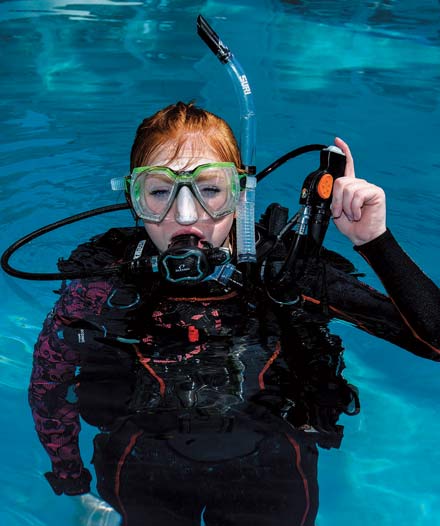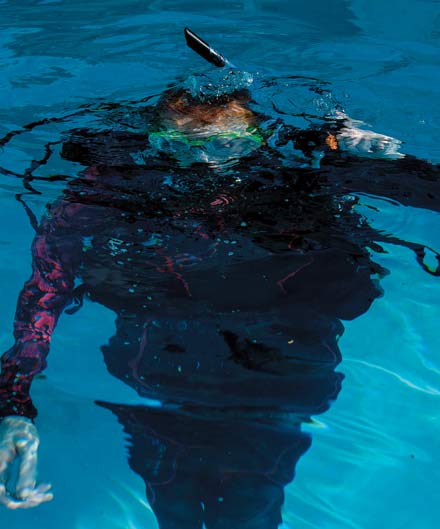Archimedes’ principle is a law of physics fundamental to fluid mechanics. And as it turns out, this law of physics is one of several that directly influences our diving. Way back in 250 B.C. the Greek mathematician and physicist stated that, “an object, wholly or partially immersed in a liquid, is buoyed up by a force equal to the weight of the fluid displaced by the object.”
In practical terms, buoyancy is the force that causes objects to float.
When equipping for a dive, one of our main objectives is to overcome that buoyant force. Our goal is to sink below the surface. Once submerged, we make adjustments necessary to achieve and maintain neutral buoyancy in order to explore the undersea world.
What affects a diver’s buoyancy, you ask?
The answer: practically everything. Factors that impact a diver’s buoyancy include the water (salt vs. fresh), the diver’s body composition, the type of equipment and exposure protection worn, the amount of air breathed, and, of course, the amount of weight worn.
The Case for Neutral Buoyancy
Proper weighting is a key ingredient to an enjoyable dive. Without enough weight, you might find yourself struggling to descend and remain at depth. This takes the pleasure out of the dive. It can also be problematic when it comes time to perform a safety stop in shallow water, as the tank will be lighter nearer the end of a dive. (Remember, the air in your tank has weight: as you consume the air, the tank becomes more buoyant.)
Wearing too much weight also has its problems. When over weighted, you may easily lose control of your descent rate, risking mask squeeze or barotrauma due to a rapid descent. There’s also the risk of descending deeper than the planned maximum depth for the dive. Being over weighted also means you will need to add more air to your buoyancy compensator (BC) to achieve neutral buoyancy. The additional air in the BC makes the torso rise slightly and since the weights are positioned around your waist, you end up swimming diagonally through the water instead of enjoying a more streamlined position.
The ability to achieve and maintain neutral buoyancy throughout a dive depends on proper weighting. And the best time to gear up in the correct amount of weight is before you enter the water — not once you’ve entered and you’re bobbing like a cork or dropping like a stone. Rather than wasting time attempting to fix a weighting problem during a dive, we suggest you spend a short amount of time beforehand, conducting a predive weight check. You’ll enjoy the feelings of freedom and ease associated with being neutrally buoyant, and you’ll be able to perform a proper safety stop, too.
Tips for Performing a Weight Check
You’ll need water that’s at least chest-deep or deeper. A swimming pool is ideal, so you can keep extra weights at poolside, within easy reach. Ask a dive buddy, friend, or instructor to assist you by handling the weights as you make adjustments. For best accuracy, be sure to wear the same equipment — tank, BC, exposure protection, mask and fins, estimated amount of weight you think you need, and any accessories (dive light, safety sausage, etc.) that you plan to wear on your dives.
Start with your BC inflated and your mask and regulator in place. Assume a near-vertical position (if in water shallow enough to stand, lift your feet off the bottom) and begin to vent all the air from the BC as you take a normal, full breath. Hold your breath for a moment and try to remain motionless. If properly weighted for neutral buoyancy, you will float at about eye level to hairline level (Photo 1). When you exhale fully, you should submerge.

[ONE] When performing a pre-dive weight check, if properly weighted, you will float at about eye level.
Photo by Barry and Ruth Guimbellot.

[TWO] If underweighted when performing a pre-dive weight check, your mask will remain above the surface. This is an indication that you need to add more weight.
Photo by Barry & Ruth Guimbellot

[THREE] If you submerge up to or beyond your mask when performing a pre-dive weight check, consider yourself over weighted and subtract a pound or two (0.45 to 0.91 kg) at a time until you float at about eye level.
Photo by Barry & Ruth Guimbellot
Tank Matters
Another factor to consider when planning how much weight to wear is that the buoyancy characteristics of your tank will change during the dive. For example, an 80 cubic-foot (8 L) aluminum cylinder is about 1.6 pounds (0.73 kg) negative when full, but is about 2.8 pounds (1.27 kg) positive with only 500 psi (34.5 bar) remaining. That’s a buoyancy differential of nearly 4.5 pounds (2 kg) from start to finish.
A high-pressure 80 cubic-foot (8 L) steel tank, on the other hand, starts off negative by about 9 pounds (4.1 kg) and finishes negative by about 3 pounds (1.4 kg).




